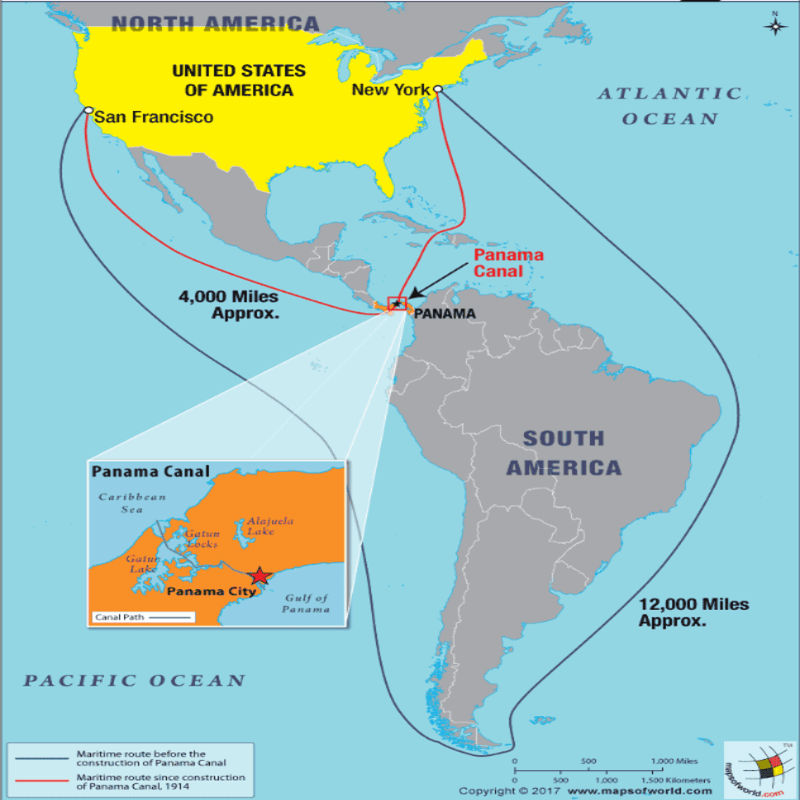
Global Trade Disruptions have cascading effects throughout the world. In the interconnected world of the 21st century, global trade is the backbone of the world economy, linking countries, industries, and markets. Read here to learn more about the impact of trade disruptions globally.
The UN’s trade and development body, UNCTAD, has raised profound concerns over escalating disruptions to global trade.
It says that recent attacks on ships in the Red Sea, combined with geopolitical tensions affecting shipping in the Black Sea and the impacts of climate change on the Panama Canal, have given rise to a complex crisis affecting key trade routes.
Maritime trade accounts for approximately 80% of the global movement of goods in international trade.
Global trade disruptions
The interconnectedness of the world through trade also means that disruptions in one part of the world can have cascading effects globally.
From natural disasters and pandemics to political instability and economic crises, various factors have caused significant disruptions in global trade.
Understanding these disruptions is crucial for businesses, governments, and policymakers to develop strategies for resilience and sustainable growth.
Causes of Disruptions
Natural Disasters:
- Earthquakes, hurricanes, floods, and other natural disasters can severely impact trade by damaging infrastructure, disrupting supply chains, and halting production and transportation. The 2011 earthquake and tsunami in Japan, which affected the global supply of automobile parts and electronics, is a prime example.
Pandemics:
- The COVID-19 pandemic illustrated how a health crisis could lead to unprecedented global trade disruptions. Lockdowns and border closures impacted manufacturing and logistics, leading to supply chain bottlenecks and a shortage of goods worldwide.
Political and Economic Instability:
- Trade wars, tariffs, sanctions, and political instability can significantly disrupt global trade. For instance, the U.S.-China trade war led to increased tariffs, affecting global supply chains and market stability.
Technological Disruptions:
- Cybersecurity threats and technological failures can also impact global trade. Cyber-attacks on major companies can halt operations, as seen in the case of the 2017 ransomware attack on Maersk, the world’s largest container shipping company.
Globalization Backlash:
- Rising protectionism and anti-globalization sentiments in many countries have led to policy changes that can disrupt global trade, such as Brexit and its impact on European trade.
Disruptions in the Black Sea and Panama and Suez Canals
The Suez Canal, a critical waterway connecting the Mediterranean Sea to the Red Sea, handled approximately 12% to 15% of global trade in 2023.
The ongoing conflict in Ukraine has also triggered substantial shifts in oil and grain trades, reshaping established trade patterns.
Meanwhile, the Panama Canal, another key artery for global trade, is grappling with a severe drought that has diminished water levels, resulting in a staggering 36% reduction in total transits over the past month compared to a year ago.
The long-term implications of climate change on the canal’s capacity are raising concerns about enduring impacts on global supply chains. The crisis in the Red Sea, marked by Houthi-led attacks disrupting shipping routes, has added another layer of complexity.
Panama Canal

The Panama Canal, an engineering marvel, stands as a testament to human ingenuity and a pivotal artery in global trade. Completed in 1914, this 82-kilometer waterway not only transformed the maritime landscape but also became an indispensable component of international trade and economics. Its significance in global commerce, geopolitical strategies, and maritime navigation is profound and multifaceted.
Strategic Location and Historical Background
Strategically located to connect the Atlantic and Pacific Oceans, the Panama Canal slices through the Isthmus of Panama in Central America. Before its construction, ships had to endure the perilous and extended Cape Horn route at the southern tip of South America. The demand for a shorter, safer passage led to the creation of this canal, fundamentally altering maritime trade routes.
Reduction in Shipping Time and Costs
- The most direct impact of the Panama Canal is the substantial reduction in shipping time and costs.
- By providing a shortcut, the canal diminishes the voyage distance by several thousand nautical miles, translating into reduced fuel consumption and operational costs.
- This efficiency is a boon for global trade, as it enhances the viability and profitability of long-distance maritime transportation, particularly beneficial for the movement of goods between Asia and the eastern coast of the United States.
Boost to Global Trade
- As a conduit for international trade, the Panama Canal supports the movement of a significant percentage of the world’s sea-bound freight.
- It facilitates the transport of various commodities, including grains, crude oil, chemicals, and consumer goods, underlining its role in feeding global supply chains.
- The canal’s capacity to handle about 14,000 transits annually underscores its significance in maintaining the flow of global commerce.
Economic Impact
- Economically, the Panama Canal is a crucial revenue stream for Panama, primarily through transit tolls.
- The canal’s operations contribute significantly to the country’s GDP.
- Beyond its national economic impact, the canal indirectly influences the economies of several countries by bolstering trade efficiency and connectivity.
Influence on Shipping Industries
- The canal’s dimensions historically dictated ship designs, leading to the development of “Panamax” vessels, specifically built to traverse its locks and channels.
- The recent expansion of the canal to accommodate larger “New Panamax” ships has further influenced global shipping trends, encouraging the construction of bigger, more efficient vessels, and thereby revolutionizing maritime transport.
Regional Development
- The Panama Canal has been a catalyst for economic and infrastructural development in the region.
- Its presence has fostered the growth of logistics, maritime services, and industrial activities, not just in Panama but also in neighboring countries.
- This development has implications for employment, skill development, and broader economic growth in the region.
Geopolitical and Strategic Importance
- Control over the Panama Canal signifies control over one of the world’s most strategic maritime passages.
- Historically, this led to significant U.S. involvement in the canal and its eventual handover to Panama in 1999.
- The canal’s role in global politics and its strategic importance in times of conflict and peace cannot be overstated, making it a focal point in international relations.
Environmental Considerations
The Panama Canal also has environmental dimensions.
- While it promotes fuel efficiency and reduces emissions through shorter routes, it poses ecological challenges, including water resource management and potential impacts on local biodiversity.
- Balancing the operational demands of the canal with environmental sustainability is an ongoing challenge.
Read: The Panama Canal is running dry
Challenges and Future Outlook
Despite its significance, the Panama Canal faces challenges, including competition from alternative routes like the Suez Canal and the potential for new passages opened up by melting Arctic ice.
Additionally, the increasing size of cargo ships and global trade dynamics require continuous adaptation and expansion of the canal’s infrastructure.
Impact of Trade Disruptions
Global implications: Increases in energy and food prices:
- Prolonged interruptions, particularly in container shipping, pose a direct threat to global supply chains, raising the risk of delayed deliveries and higher costs.
- Energy prices are witnessing a surge as gas transits are discontinued, directly impacting energy supplies, especially in Europe.
- The crisis is also impacting global food prices, with longer distances and higher freight rates potentially cascading into increased costs.
- Disruptions in grain shipments from Europe, the Russian Federation, and Ukraine pose risks to global food security, affecting consumers and lowering the prices paid to producers.
Other general implications:
- Economic Slowdown: Trade disruptions can lead to reduced economic growth, inflation, and increased unemployment.
- Supply Chain Challenges: Disruptions can expose vulnerabilities in global supply chains, leading to delays, increased costs, and reduced efficiency.
- Shift in Trade Patterns: Disruptions often force companies to diversify supply chains and explore new markets, leading to shifts in trade patterns.
- Impact on Small Businesses: Small and medium-sized enterprises (SMEs) are particularly vulnerable to trade disruptions due to their limited resources.
- Impact on developing countries: Developing countries are particularly vulnerable to these disruptions.
Strategies for Mitigating Trade Disruptions
- Diversification of Supply Chains: Businesses are increasingly looking to diversify suppliers and logistics options to reduce dependency on a single source or route.
- Investment in Technology: Investing in technology like AI, blockchain, and IoT can enhance supply chain resilience by improving visibility and predictive capabilities.
- Strategic Stockpiling: Maintaining strategic reserves of essential goods can help cushion the impact of disruptions.
- Flexible Business Models: Adopting more flexible business models, including localizing certain operations, can help companies adapt to changing scenarios.
- Policy Measures: Governments can play a crucial role by creating policies that support trade resilience, such as trade agreements that include provisions for emergencies.
Conclusion
Global trade disruptions, while challenging, also offer opportunities for companies and countries to innovate, adapt, and build more resilient systems. By understanding the causes and impacts of these disruptions, and by implementing effective strategies, the global economy can better withstand future shocks. In an era where change is the only constant, agility, and adaptability in global trade practices are not just beneficial but essential for long-term sustainability and growth.
Read:
-Article by Swathi Satish





This article shows how global trade disruptions seriously affect the economy. Since maritime trade is so important, it’s worrying to see how political issues and climate change threaten key shipping routes. What can we do to protect these important lanes and make trade smoother in the future?